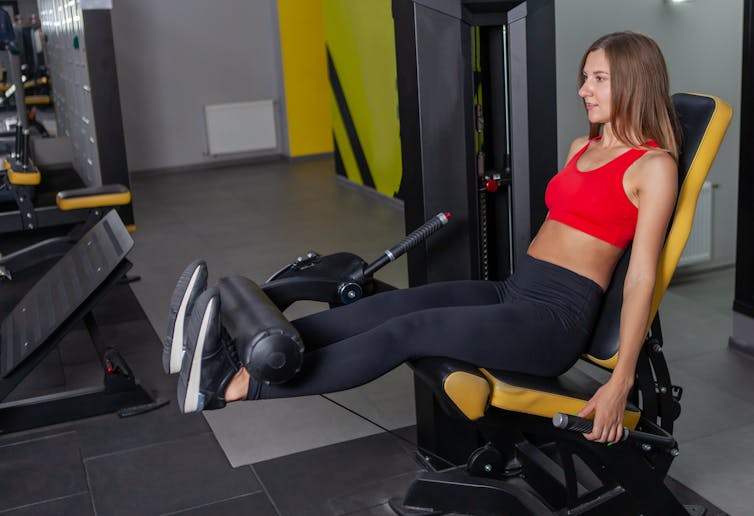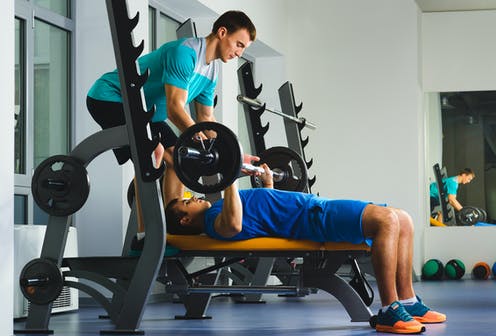Resistance training is an increasingly popular way to build strength, lose weight and get in shape. But despite its many benefits, it can also be time consuming – which is why many fitness enthusiasts have started incorporating “supersets” into gym routines. When done properly, supersets have the potential to help you build strength and muscle – all while spending less time in the gym.
Sometimes called paired sets, supersets are a form of strength training in which you perform a set of repetitions of usually two exercises, back-to-back with minimal or no rest between them. The exercises should also target opposing muscle groups – namely the agonists (the force-generating muscles) and the antagonists (the muscle that relaxes when the agonist contracts). For example, leg curls (where the hamstrings are the agonists and the quadriceps the antagonists) would typically be followed by leg extensions (where the quadriceps are the agonists and the hamstrings the antagonists) to make up a superset.
However, many people perform supersets incorrectly. Many believe supersets to be the same as compound sets, in which two exercises engaging the same muscle group are performed back-to-back. Or they get confused with contrast training, in which two similar exercises are paired to increase power, the first performed with a heavier load, while the second is performed explosively with a lighter load – such as heavy squats followed by vertical jumps. Many also think supersets comprise upper and lower body exercises performed in succession.
The science of supersets
Based on current research, it appears that supersets can be a time-efficient way to develop muscle size and strength in the short-term when done properly.
Researchers have compared the effect of performing exercises in a traditional sequence (for example, completing four sets of bench presses before moving onto the next exercise) and as supersets. They found superset workouts are faster (completed in 31 minutes as opposed to 40) because the superset exercises were done in pairs, instead of pausing after each individual exercise.
They also found supersets required the body to use more stored energy (such as fat and carbohydrates) during exercise and for an hour afterwards. This could ultimately increase fat burning, and may even lead to more muscle gain as supersets mean more work is performed.
A similar study also found that supersets required a person to work 8% harder than traditional sets. This means that you can use supersets to complete more resistance training in the same or less time – and this may be as effective as traditional routines. Working harder may also burn more calories during and after exercise.
Another study had participants perform a pair of pull-push exercises (bench pull and bench press) in both traditional format and as supersets. Rest periods for all types of exercise were controlled to two minutes, so that each training session only lasted ten minutes. They found that supersets allowed participants to work harder as they were able to complete more reps in ten minutes compared to the traditional format. More work completed in the same time demands greater effort, which could result in greater strength and muscle gains (although this hasn’t yet been proven).
Not only that, but the order superset exercises are performed in could also impact performance. One study found that performing a leg curl followed by a leg extension allowed participants to perform more reps while feeling less difficult to perform than doing the exercises in separate sets. The researchers weren’t sure why this was the case, but it could be due to the large quadriceps muscles being activated during the leg curl, making the leg extension easier to perform.

Vladimir Sukhachev/ Shutterstock
Supersets may also be slightly less exhausting than traditional sets. One study compared a superset (bent over row followed by a bench press), with two versions of compound exercises (either a dumbbell bench press followed by a regular bench press, or a back squat followed by a bench press). Participants also completed a control session of three sets of bench presses.
All pairings comprised three sets of ten repetitions at 65% of the maximum load a person was able to lift in one repetition, with two minutes’ rest in between sets. Participants found all paired exercises felt difficult to perform and resulted in loss of speed and power compared to the control session. However, the superset felt less difficult to perform than the control or the compound exercises and resulted in less speed loss overall – so was likely to be more effective when time was limited compared to the other formats.
Short-term versus long-term
It’s worth noting, however, that many of the above superset studies used different exercise intensities, and had people lift different volumes of weights, making it hard to properly compare results. For example, reducing intensity (with lighter weights), while increasing volume (with more repetitions) might enhance muscle gains over the long-term, while low volume, high-intensity supersets might be better for developing maximal strength and power.
Most superset studies have only looked at the effects in the short-term, during a single exercise session – so it’s uncertain whether they’re more effective than traditional resistance training for building strength, muscle size, or both. Results will likely depend on the combination of the number of sets, reps, load and rest periods performed.
But in the short-term, current evidence shows supersets allow you to complete more work in less time because of their intensity. This has the potential to burn more calories, both during and after the training session. But the intensity (loads lifted), volume (number of sets and reps) and order of the exercises within the superset are potentially important for maximising these benefits.
![]()
The authors do not work for, consult, own shares in or receive funding from any company or organization that would benefit from this article, and have disclosed no relevant affiliations beyond their academic appointment.











